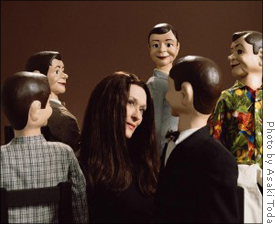
| << Front page | Arts | February 29, 2008 |
Simmons Enlivens the Inanimate
 |
||
| Not just a bunch of dummies Simmons’s visual art background is prominent in The Music of Regret. | ||
Regardless of your opinion of its artistic merit, there is undeniable humor in the image of Meryl Streep and a ventriloquist dummy lying side by side on a moonlit beach, singing a Hawaiian love song to one another. This was just one way the inanimate world — dummies, hand puppets, dollhouse furniture and birthday cakes — came alive in The Music of Regret, a film musical in three acts directed by Laurie Simmons. The film was screened in Hallock Auditorium Wednesday evening with Simmons on-hand to provide insight.
Simmons explained that each of the musical’s three acts is based on photography or sculpture series from her adult years of art making. Much of her work incorporates arrangements of dollhouse furniture, puppets and dolls in small, closed-off rooms.
“With dolls, you don’t have to face emotion head-on,” Simmons related. That said, in the course of her career, she has become adept at taking a plastic doll and “punching emotion into it.”
Bringing these ideas to film was a very exciting process for Simmons, especially with a team of high-profile individuals, including Streep; Edward Lachman, a seasoned Hollywood cinematographer; and Adam Guettel, composer of the award-winning musical The Light in the Piazza, who provided the singing voice for the film’s ventriloquist dummies.
Simmons brought her visual art background to the film, which was evident in its spare overall appearance and the fact that its three acts have no clear narrative relationship. But the best part about it was the humor. In the first act, one hand-puppet businessman explained to another that he got a new job because he wore a stylish tie to the interview and in the third act, a pistol with dancing legs auditioned for a show.
Simmons wrote all the lyrics to the songs in the film, which are inspired by her love for classic musical theater. In the musical’s second act, Streep’s character sang several songs to several differently dressed, but otherwise identical, dummies. Each scene was representative of a different love affair. The act seemed to go on a little too long and its songs ranged from great — the Hawaiian song “Excellent Moon,” — to mediocre; some of the slower ballads were a little stagnant. But this act includes what Simmons considers her most victorious moment in production: Streep became so emotional in one scene with a dummy that she cried on film.
About us
Subscriptions
Advertising